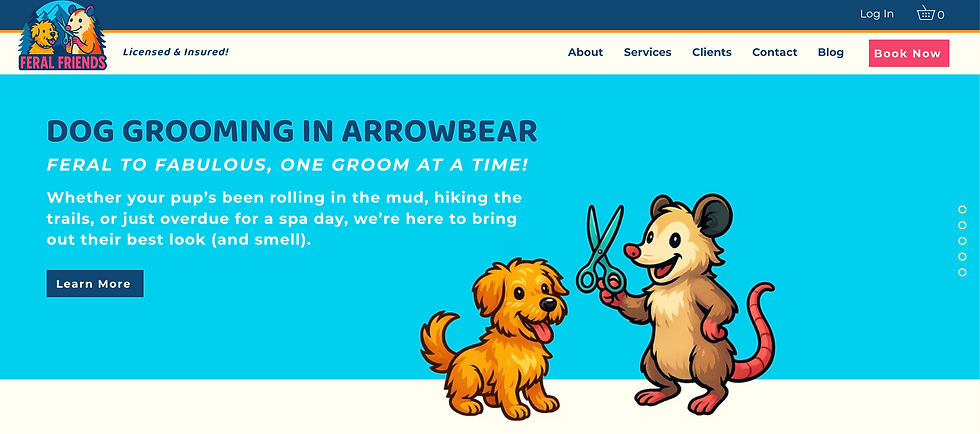10 Mistakes Business Owners Make on Their Wix Website
- Border7 Studios

- May 17, 2022
- 5 min read
Keep these 10 mistakes in mind, so you can avoid making them on your website!
1. Inconsistent branding on website, social media & marketing materials
Branding can feel particularly overwhelming in the beginning. There are a lot of directions you could go, and it might feel like once you pick something you're "stuck."
The truth is that one of the most important aspects of branding is consistency. This is where you not only start building awareness about a brand, but you also build trust.

Consistent branding shows that you as a business are consistent. It helps to set expectations with your audience, and helps make you look more professional.
Make sure that your branding is consistent online and with the materials you use to promote your business.
2. Don't clearly state information to the 5 must-answer questions
When a visitor lands on your website, you only have a few seconds to communicate key information to them that will help them make a decision.

This decision can involve immediate action (if they want to do business with you), or a more long-term relationship that could result in an action in time, (sign up for a newsletter to receive more information, read articles to learn more about the service or product you provide, or following you on social media).
The 5 questions you want to make sure you address on your homepage are:
What you do
Who it's for
Why they need it
Why trust you
What they should do next
If a visitor decides not to take any type of action, and leaves the website, it could be because they were the wrong audience, or you didn't communicate the information they needed to make a decision.
Addressing the above 5 questions is a great way to ensure you're covering your basis, and they have the information they need to make a decision.
3. Creating a unique site layout for the sake of it being different
This is a mindset that some business owners have where they want their website to be "unlike any other website out there."

The problem with this approach is that different does not mean it's user-friendly, or easy to navigate.
If the navigation is difficult to use, or a visitor isn't sure what they should do next on the website, the chances of them leaving the website go up.
This means that the desire to have a unique design can actually sabotage all the efforts it took to get them on your website.
When in doubt, keep it simple.
There's a reason why big, popular websites like Lowes, Apple, and Wix have a simple, straight-forward navigation. They want to make sure that a visitor to their site can find what they're looking for quickly and efficiently.
Don't overcomplicate things for the sake of being "different."
4. Not taking the time to define your target audience
Building your website is an exciting time. It can be tempting to use colors and images you like personally, but it's important you have a specific audience in mind when creating your website.

In addition to your industry and the service or product you provide, your target audience's gender, age, interests, and location can all factor into the website's design, the overall structure, messaging, and marketing strategy for your business.
Taking time to establish your target audience will help ground you as you work to build your website. Anytime you think about making a change, consider if it supports your specific audience.
5. Listening only to friends and family for feedback
It's okay to ask for opinions from friends and family from time to time, but if they aren't your target audience, it's possible it can lead you down a rabbit hole of constantly making changes.

There are always new changes in design, technology, and marketing tactics. If you're too quick to change your mind, it'll be hard to make progress and start gathering data on your new website.
Instead, ask them for specific feedback like if they found your website easy to navigate.
If they got stuck anywhere, or weren't sure what to do next, ask them to make a note of it. This will help you pinpoint any areas that could be leading to a drop off. You can then compare this to your analytics to see if this is a trend that needs to be corrected.
6. Forgetting to create a marketing plan to drive traffic & build awareness
You can have the most beautiful website in the world, but if no one can find it, it's not going to achieve the results you'd hoped.

Make sure you have a marketing plan for how visitors will find your website, how you plan to build a community, and what education might be needed so you're considered as a top option.
It should include more than one tactic, and outline specifically how you plan to reach your target audience.
7. Not having optics on your data & how your site is performing
Your data doesn't lie. Having optics on your data is crucial to understanding the success of your web efforts.

The numbers will tell you what's working and what isn't. It will also tell you more about your target audience and how they interact with your website.
Once you have optics on your data, you can then use these metrics to make data-driven decisions.
Through your data, you can set a goal, and benchmark where you are now to then work backwards to figure out what steps you need to take to get there.
8. Making gut-decisions instead of data-driven decisions
Data helps take the emotion out of the decision making process.

Without clear optics on what's going on, there's no guarantee that the steps you're taking will lead to your goal.
Through data, you can better understand where you are now, what's working and isn't working, and establish where you'd like to be.
Some examples of website data is traffic volume per month (how many users visit your website), acquisition of traffic (where your traffic comes from), and bounce rate (when a user lands on the site & leaves quickly).
9. Not taking action when you need to, paralysis by analysis
Once you're tracking and analyzing your data, there will be times where it's hard to make a decision because you want to gather more information.

There's nothing wrong with being cautious, but sometimes you just need to take action, and get something going.
Don't let your data become an excuse from trying new things, or taking action, but always be mindful of it before you decide to make a major change.
10. Trying to take on too much at once
As a business owner, it can feel like everything is on your shoulders. To be fair, we probably put more tasks on our plate than others because we're highly motivated.

However, it's important that you don't assign the same level priority to every to-do on your list.
Otherwise, you'll end up feeling overwhelmed, eventually burnt out, and like you're not making the progress you had hoped.
Instead, focus on the top 3 things that need to happen that week, and break it down so you can make progress each day.
If something is time sensitive, or will have the biggest impact on your business, make it a top priority and try to not get distracted by the other inevitable tasks that arise.





